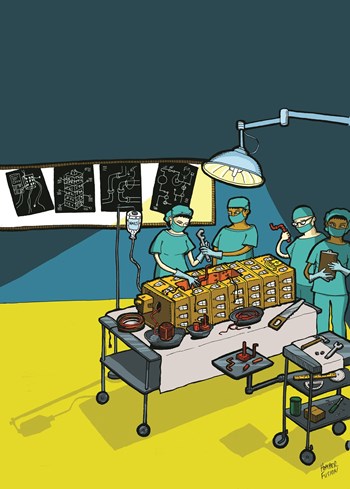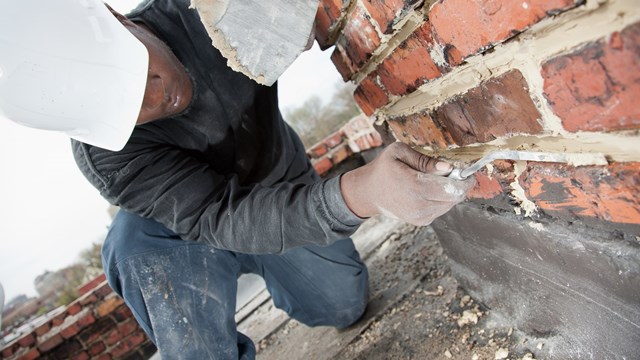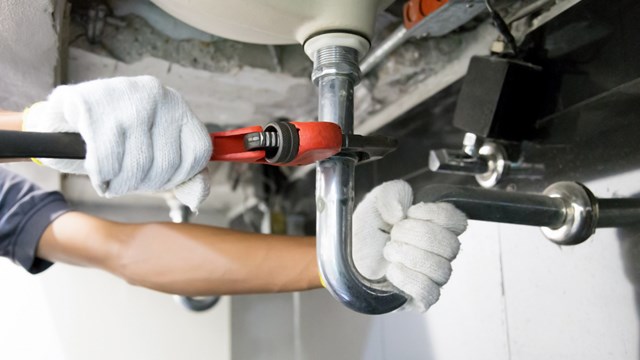
If you think about it, a multifamily building isn’t that much different than the human body. Both house important complex operating systems and organs. Both take in fuel and produce waste, and both require regular check-ups and a good maintenance program to stay healthy and thriving.
And just like humans need to see doctors regularly for updates on the heart, lungs and eyes, buildings need to have examinations of its systems as well, with regular checkups required.
Charles A. Merritt, PE, president of Merritt Engineering Consultants, P.E., which has offices in Davie, notes that a multifamily building’s primary operating systems include the building envelope, waterproofing, electrical, mechanical, plumbing, elevator systems, as well as heating, ventilation and air conditioning, or HVAC. “Each of the building systems can present a number of problems that will affect the level of comfort in the building,” Merritt says. “One notable problem that can affect a building as a whole is a lack of insulation, along with air and water infiltration from the building envelope. Improper insulation leads to inefficient operation of the mechanical systems associated with the building.”
The Air in There
With the average daily temperature hovering around 82 degrees, Floridians take their air conditioning very seriously. There are two common systems. The first is a chilled water system, which requires one central plant on the ground or the roof, which provides cool water to a series of fan coils within each condominium unit.
“We see these systems in a lot of condos,” says Keith Walker, owner of Quincy’s Heating & Air Conditioning, Inc., in Panama City Beach. “The efficiency with this system is that you have one central point that provides all the cooling capacity to each unit.”
The second most common system is known as a DX split system. “This is a more traditional air conditioning system where you have an air handler located inside the condo unit and you have one condenser paired to that air handler, which is usually located on the roof,” says Walker.
Like all operating systems, both DX split systems and chilled water tanks have operational issues. “If the central plant were to go down in a water-based system, then the entire building would lose its air conditioning unless there was a redundant plant,” says Walker. “But the main problem we see with both systems is mold.”
In order to avoid air conditioning related issues, Walker suggests having your building's operating system inspected twice a year—what he referred to as a preventative maintenance agreement, or PMA. “Any reputable air conditioning company can do that,” says Walker. “Typically we do it spring when the snowbirds leave, and in fall when snowbirds come in as well, but it can be done at any time during the year.”
Keeping the Rain Off
The key components for keeping conditioned air conditioned—that is, cool or warm and safe to breathe—are the roof and the building’s envelope. If these systems break down, it can trigger a cascade of other problems.
“The roof protects the building’s structural integrity and keeps the property dry,” says Sheila Keane, business development specialist at Tom White Painting & Restoration in North Pinellas. “The building envelope sheds water and helps prevent it from damaging the shell.”
While many boards have management companies, chief engineer or superintendents overseeing these various systems, it is often hard to tell with the naked eye when problems are afoot. “Roofs should be inspected annually by a licensed roofer,” says Keane, adding that the average life span of a roof is 20 to 30 years with regularly scheduled maintenance. “There are different roof systems, different coatings such as bitumen (also called asphalt), and they all have to maintained and inspected.”
Check Up Time
William Pyznar, P.E., principal of The Falcon Group, which has engineering and consulting offices in Miami, says each piece of equipment association with one of the main building systems has an anticipated useful service life.
“The useful service life is the duration, in years, in which the equipment is expected to properly operate,” he says. “The useful service lifetime varies by equipment and is typically included in the equipment schedule provided in a reserve study. There are numerous ways in which equipment can degrade and fail over time. Equipment that is properly maintained since installation should be able to last for the duration of the anticipated useful service life.”
According to the experts, major building systems should be inspected every two to three years, and every building should have a maintenance plan that includes evaluations of all building systems to prevent large costly projects in the long run.
“Typically, the most efficient way to evaluate the performance of building systems is to conduct a building-wide physical survey and engineering evaluation,” Merritt says. “This evaluation includes the assessment of physical needs of site conditions and installations (sidewalks, parking areas and driveways), building envelope and appurtenances (roofing system and roof structures, existing waterproofing), building interior systems and finishes, and all primary building mechanical, electrical and plumbing systems, and elevator systems.”
In the event of an immediate area of concern, it is highly recommended that building owners hire a registered design professional to inspect the integrity of all major building components and most important, ensure that the building is structurally sound.
Pyznar notes the frequency of routine service on a multifamily building’s central equipment will vary substantially, but excellent equipment performance begins with proper project commissioning to ensure proper installation and startup.
“After equipment is installed, maintenance should be performed by a qualified professional in accordance with the manufacturer’s recommendations,” he says. “The building manager and maintenance staff should have service contractors available for routine maintenance of central HVAC, plumbing, electrical, life safety, and elevator equipment.”
Christina Grubbs, P.E., a manager and engineer with Karins Engineering Group in St. Petersburg, notes that weather plays a prominent role in the eventual wear of mechanical systems. Specifically, the intensity of UV rays—given Florida's proximity to the equator—does a number on buildings, as does salt backup, and, of course, water infiltration.
The latter is reinforced by Jamey Ehrman, a senior engineer for RAND Engineering & Architecture in New York City, who vouches that "water infiltration is the most common ailment of a building," and can cause unsafe facade conditions.
Taking Charge
While, as Grubbs made clear above, the interpretation of building code may vary throughout the state, it's quite sensible that all buildings, all parts thereof, and all other structures should be maintained in a safe condition. Furthermore, the owner shall be responsible at all times to maintain the building and its facilities, and all other structures regulated by the code.
“The building staff should familiarize itself with early indicators of problematic conditions,” Merritt says. “The staff, board, and managing agent can then coordinate a regular maintenance plan to ensure the proper inspections are performed, and any necessary repairs are specified and carried out by a qualified design professional.”
A multifamily building’s board or shareholders have a fiduciary responsibility to act in the best interest of the building, and typically make top-level decisions regarding building projects and maintenance practices.
“The management and facilities staff is responsible for carrying out projects and maintenance tasks on behalf of the board,” Pyznar says. “Every facilities staff has a different range of expertise and resources. Some buildings or communities have a large team of full-time maintenance staff members, allowing for the majority of daily and annual maintenance work to be performed in-house. Smaller buildings might have a part-time super who is responsible for daily maintenance items only.”
Delegate Responsibility
Since the members of a board are typically volunteers who are elected to their position, they need to delegate responsibilities so that the building can operate in a practical fashion. Having building maintenance personnel, building management, and even residents keeping an eye out for issues that need to be addressed is considered part of good practice.
“Quite often, analyzing these systems goes beyond the expertise of building maintenance personnel and building management, which is why building owners often retain the services of HVAC system service contractors, plumbers, electricians, elevator service companies, etc.,” Ehrman says. “For more complicated issues, it may be necessary to bring in an architect or engineering specialist for that specific issue. As far as specifics to a schedule, that is really dependent on the type of system within a building.”
And Grubbs advises that a specialist should be called in when any potential problem with a mechanical system can pose a life safety issue. If there is ever any type of health threat toward occupants, the job most likely goes beyond the purview of standard maintenance personnel.
Finally, says Pyznar, “It is highly recommended that all multifamily buildings, large and small, have their reserve funds routinely evaluated by a qualified reserve specialist.”
Keith Loria is a freelance writer and a frequent contributor to The South Florida Cooperator. Staff writer Michael Odenthal contributed to this article.






Comments
Leave a Comment